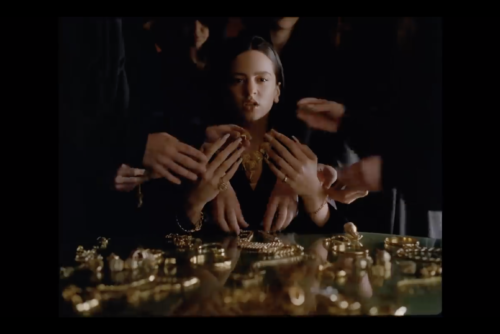In cummings’ rendering, Baker’s “crossed eyes” and warbling limbs surely re-enact Topsy’s “black, glassy eyes glittering with a kind of wicked drollery,” while Topsy’s “clapping hands” and “knocking knees” give proleptic embodiment to the “incomparably fluid nightmare” of Baker’s minstrel-like performance in Dandies. And it is the transformation of this seemingly “terrifying nightmare” into the “most beautiful … star of the Parisian stage” that brings shock and delight to the American poet, who is captivated by the “perfectly fused [and] entirely beautiful body and a beautiful command of its entirety” (Firmage, 161-162). Describing her performance on the stage of the Folies Bergère, the poet further muses:
[Baker] enters through a dense electric twilight, walking backwards on hands and feet, legs and arms stiff, down a huge jungle tree—as a creature neither infrahuman nor superhuman but somehow both: a mysterious unkillable something, equally non primitive and uncivilized, or beyond time in the sense that emotion is beyond arithmetic…. By the laws of its own structure, which are the irrevocable laws of juxtaposition and contrast, the revue is a use of everything trivial or plural to intensify what is singular and fundamental … Mlle. Josephine Baker. (Firmage, 162-163)
Like Levinson, cummings’ review encodes an atavistic and phallic image of “a creature walking backwards … legs and arms stiff,” ironically descending from the plinth of nature into the white male colonial dream world, an image that conflates the world of nature and that of human desire. Juxtaposing the affects of modern technology with that of the savage jungle staging (“Baker enters through a dense electric twilight”), cummings’ description of her arboreal descent metaphorically fragments her body into “hands and feet [and] legs and arms,” enacting a linguistic dismemberment that re-inscribes the discourse of American slavery, but framed within the discourse of the European primitivist colonial imaginary. Thus, while cummings’ reading of Baker’s 1926 performance necessarily reflects a postcolonial, that is to say American, perspective not entirely dissimilar to his reading of Baker’s earlier performance, his re-construction of Baker also bears the imprint of the colonial gaze that is exemplified in Levinson’s reading.
Again, like Levinson, cummings’ reading of Baker registers the affect of her performance more than it does her presence; in fact, her presence in both readings is defined paradoxically by her spectacular absence. Cummings, in fact, locates Baker in a space of radical negation—that is say in terms of what she is not: “as a creature neither infrahuman nor superhuman but somehow both … equally nonprimitive and uncivilized …” (italics mine). The multiple negations here, in effect, beg the question of her actual “humanity,” culminating in the incantation of “a mysterious unkillable something” [italics mine], an image that not only confounds Baker’s location between the civilized and primitive, but significantly betrays the poet’s inability to position the subject between the less than human (“infrahuman”) and more than human (“superhuman”). Finally, unable to successfully de-colonize the postcolonial gaze, cummings’s construction of Baker morphs from the embodied and fragmented representation in the “colonial unconscious” into something transcendent, indestructible, and irreducible, suggesting her release, whether from the captivity of her earlier minstrel masquerade (“the Folies Bergère permits Josephine Baker to appear—for the first time on any stage—as herself”) or from her entrapment in the hunter’s colonial dreamscape, remains equivocal. Unknowable, indefinable, unnamable, unclassifiable, the performing subject can only be conjured by the poet as “a mysterious unkillable something.”
Notably, cummings’ readings of Baker’s performance in the Folies Bergère fixate on qualities that he describes as “singular and fundamental.” And speaking of her earlier performance in Chocolate Dandies, he observes that it “suggests nothing but itself and … consequently, was strictly aesthetic” (Firmage, 161). Similar to Levinson, then, who compares Baker “to the finest examples of Negro sculpture,” cummings aligns her performance with the elitist and modernist notion of “aesthetics” that is defined by its singularity and self-referentiality. Ultimately, whether grotesque or beautiful, immanent or transcendent, nightmarish or sublime, in the poet’s imagination Baker is constructed in terms of oxymorons: “uncouth” and “exquisite,” “personal” and “racial,” “rigid” and “liquid,” contradictions specific to the a-cultural and de-historicized modernist notion of aesthetics prevalent during the period. Finally, while revealing himself transformed by the power and force of Baker’s performance, as a spectator, cummings actually fails to apprehend, or “see,” the subject who represents, for him, an ambiguous and allusive figuration of modernist aesthetics. Words fail the poet: the image before him remains “beyond time in the sense that emotion is beyond arithmetic”—or, as I read this rather extraordinay passage, in the sense that passion exceeds reason, and sensation exceeds the sensible.
To recapitulate, Levinson and cummings’ readings are meant not only to expose the workings of the French colonial and the American postcolonial imaginary—along with the workings of the dominant (critical and poetic) codes of aesthetic signification as they construct Baker’s performances—but, more importantly for my purposes, to make a case for shifting the frame of reference within which to read Baker’s performances. Just as I argue that Baker’s dance performances disrupt an ethnocentric colonial discourse of dance on the one hand and a postcolonial, modernist, aestheticized notion of performance on the other, so this project is intended to disrupt the discursive frames of reading and reference represented paradigmatically by Levinson and cummings’ reviews of Baker’s performances.
The erasure of Baker’s embodied subjectivity encoded in the above readings and representations effectively obliterates dance itself as both an identity-constituting performance and as a signifying system capable of a politics of resistance. The counter-reading proposed here is thus based on a twofold assumption: first, that Baker’s dancing—which I re-read in the context of diaspora—enacts the potential for resistance (though not in ways that are unproblematic), and second, that her performances are fundamentally personally and culturally identity-constituting. In this way, Baker’s dance performances, I argue, manifest the potential to unsettle the (post)colonial gaze, and thereby disrupt the dominant and hegemonic discourse.



